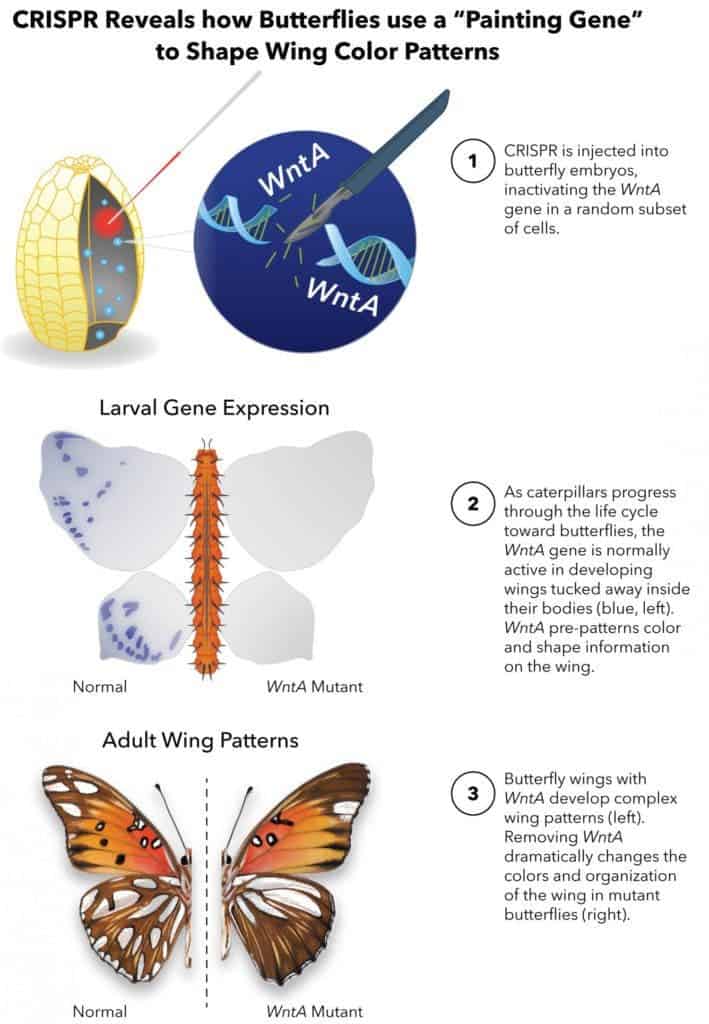From eery iridescence to perfect camouflage, butterfly wings are colored in all sorts of intricate patterns. Given their sheer diversity, scientists have always thought that a complex melange of genes code such decorative forms. It turns out, however, that playing around with just two genes is enough to determine the wing’s lines and colors.

The findings were reported this week in the Proceedings of the National Academy of Sciences journal by an international team of scientists led by Bob Reed, an evolutionary developmental biologist at Cornell University in Ithaca, New York.
The two complementary genes, WntA and optix, were identified after the team altered the genomes of several butterfly species with CRISPR–Cas9 — a powerful gene editing technique which allows scientists to cut and paste DNA sequences. The pair of genes represents ‘adaptive hotspots’ since these code physical changes in the butterfly wings that appear to be adaptations to their environment.

Paint-by-number genes
When the genes were switched on and off in various species, among them the famous but gravely endangered monarch butterfly (Danaus plexippus), interesting things happened. Turning off WntA caused the markings and patterns on the wings to fade or disappear altogether. In monarchs, for instance, the trademark dark wing contouring faded to gray.
“Imagine a paint-by-number image of a butterfly,” said Owen McMillan, staff scientist at STRI and co-author, in a press relase. “The instructions for coloring the wing are written in the genetic code. By deleting some of the instructions, we can infer which part says ‘paint the number two’s red’ or ‘paint the number one’s black. Of course, it is a lot more complicated than this because what is actually changing are networks of genes that have a cascading effect on pattern and color.”
While WntA seems to color boundaries and borders, optix acts like a paintbrush that fills in the blanks. For example, when the team switched off this gene in the butterfly gulf fritillary (Agraulis vanillae), their wings turned gray or black instead of the characteristic red and orange color patterns.
Surprisingly, when optix was turned off in the common buckeye (Junonia coenia), its wings became covered in spots of bright, iridescent blue. This signals that the gene is responsible for physical changes beyond pigmentation, since iridescence is determined by tiny microscopic structures on the wing’s scales. This suggests the optix gene “probably played a huge role in wing evolution”, Reed told Nature.
“The butterflies and moths, the Lepidoptera, are the third largest group of organisms known on the planet,” said Arnaud Martin, now Assistant Professor of Biology at George Washington University and corresponding author of the study.
“Once we identified the sets of genes regulated by a gene like WntA, we can look at the sequence of different butterflies in the family tree to see when and where these changes took place during the 60 million years of butterfly evolution.”
Such research serves to provide more insight into butterfly evolution. It’s likely that WntA and optix are part of a wider framework that allowed the insects to constantly morph their appearance according to the environment. One prime adaptation is mimicry, an unusual behavior where animals take on the appearance of another, usually for protection.
What's this? A snake, right? Wrong! Amazing mimicry via @SensoryEcology http://t.co/JgIvc1dYU1 pic.twitter.com/roGGNikpLc
— Arran Frood (@arranfrood) May 22, 2015
“For us who are studying butterflies, which are non-traditional organisms for a laboratory, CRISPR is opening a treasure chest of opportunities we haven’t had before,” Martin told Nature.


